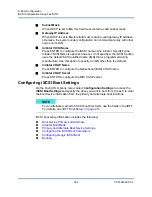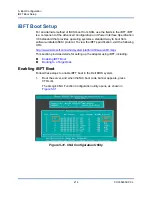
5–Boot Configuration
iSCSI Configuration Using Fast!UTIL
206
CU0354602-00 L
Boot Protocol Configuration
Boot protocol primary and alternate boot device settings include the following:
Security Settings
—Press ENTER to access Primary Boot Security
Settings. Press ENTER to enable or disable CHAP and bidirectional CHAP
and to configure the CHAP name and CHAP secret. (Depending on your
configuration, it might not be necessary to configure this option.)
Target IP
—When the Adapter Boot Mode is set to
Manual
, you must use
this field to specify the IP address of the intended iSCSI boot target.
Target Port
—Enter the port used by the target.
By default, iSCSI uses port 3260. Do not modify this value unless it is
necessary.
Boot LUN
—Enter the LUN of the boot device. (Depending on your
configuration, it might not be necessary to change this option.
iSCSI Name
—Enter the iSCSI name of an intended boot target. (Depending
on your configuration, it might not be necessary to configure this option).
Static iSCSI Boot Configuration
Use the QLogic iSCSI
Fast!
UTIL BIOS to configure static iSCSI boot parameters.
Refer to
“Configuring the iSCSI Boot Parameters” on page 204
.
Dynamic iSCSI Boot Configuration
Dynamic iSCSI boot configuration primary and alternate boot device settings
include the following:
Security Settings
—Press ENTER to access Primary Boot Security
Settings. Press ENTER to enable or disable CHAP and bidirectional CHAP
and to configure the CHAP name and CHAP secret. (Depending on your
configuration, it may not be necessary to configure this option.)
DHCP Dynamic iSCSI Boot Configuration
—Select this option to have the
initiator acquire its IP address from a DHCP server. The initiator also
acquires all boot parameters for an iSCSI target if the boot parameters are
specified on the DHCP server This setting requires advanced users to
manually input vendor-specific information the DHCP server and in the
Vendor ID
field of the DHCP Boot Settings area.
Vendor ID
specifies the identification string sent to DHCP server.
Alternate Client ID
is the additional filtering option to set the boot device.
Configure Parameters
for the secondary adapter.
Select Host Adapter
if you have multiple adapters in your system, select,
view, and configure the settings of a specific adapter.
















































